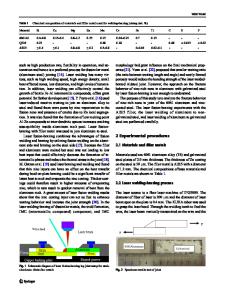Cyclic deformation and fracture behavior of Al alloy 6061 under the action of positive mean stresses
- PDF / 2,235,402 Bytes
- 11 Pages / 597 x 774 pts Page_size
- 12 Downloads / 349 Views
I.
INTRODUCTION
A S Y M M E T R I C A L cyclic loading with positive mean stress usually results in cyclic creep) ~] Because of the complexity of the problem caused by the cyclic creep, or more accurately by the interaction between creep and fatigue, the cyclic deformation response and the fracture behavior of most crystalline materials under a positive mean stress condition are less understood. In applications related to energy generation and transition, such as turbines, pressure vessels, and pipelines, serious failure problems resulting from this kind of loading condition sometimes occur. Therefore, it is necessary to study the material behavior under these conditions. The superposition of a cyclic stress may cause either cyclic creep acceleration (larger creep rate) or retardation (smaller creep rate) even if under the same maximum stress. It has been reported that with increasing maximum cyclic stress, cyclic creep retardation may give way to cyclic creep acceleration in pure fcc metals, such a s A1,12'3'41 C u , 15-81 and also some alloys. 18-~l Thus, the threshold stress for such a transition has recently drawn attention. Unfortunately, the limited results available at present seem to contradict each other. For example, Lorenzo and Laird [51 proposed a method t~)r predicting the threshold stress from some data on AI and Cu under the complete unloading condition R = 0. (R is the ratio of the minimum stress to maximum stress for a cyclic stress.) Their empirical relationship shows that the product between the threshold stress normalized by shear modulus and the temperature compensated by the absolute melting temperature is a universal constant. However, more recent experimental results with AI have shown that trace impurities, grain size, cyclic stress frequency, and mean stress will all strongly affect the threshold stress. 12'31 Moreover, the research mentioned ZHI'AN YANG, on leave from the State Key Laboratory for Fatigue and Fracture of Materials, Institute of Metal Research, Academia Sinica, Chenyang, China, is a Post Doctor, Department of Metallurgy and Materials Science, University of Toronto. ZHIRUI WANG, Associate Professor, is with the Department of Metallurgy and Materials Science, University of Toronto, Toronto, ON M55 I A4, Canada. Manuscript submitted August 31, 1992. METALLURGICAL TRANSACTIONS A
above was mostly performed on pure metals and a few simple alloys and mostly under conditions without compressive stress. Although both cyclic stress-strain curves and prediction of fatigue life under the condition of symmetrical cycling have been well studied, only limited research has focused on the mean stress effect under load-controlled fatigue conditions and the majority of such studies were performed when R was less than or equal to zero. Pokluda and Stanek 1121 systematically studied two steels in constant load-amplitude tests and found the following regularity: the cyclic plastic strain range (PSR), which is defined as the width of the hysteresis loop and is twice the cyclic plastic strain a
Data Loading...











